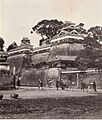Tomishige Rihei facts for kids
Quick facts for kids
Tomishige Rihei
|
|
|---|---|
| Born | May 19, 1837 Yanagawa Fukuoka Prefecture, Japan
|
| Died | February 7, 1922 |
| Nationality | Japanese |
| Occupation | Photographer |
| Known for | Photographs of Kumamoto before and after the Satsuma Rebellion (1877) |
Tomishige Rihei (富重 利平, May 19, 1837 – February 7, 1922) was a very important Japanese photographer. He lived a long time ago, from the 1800s to the early 1900s. He was one of the first people in Japan to use a special photography method called 'wet-plate photography'. This method used glass plates coated with chemicals to capture images. He was famous for his amazing, large landscape photos. Many people in the Kyūshū area of Japan know him well.
Contents
Tomishige Rihei: A Pioneer Photographer
Tomishige Rihei was a groundbreaking photographer in Japan. He helped introduce new ways of taking pictures. His work shows us what Japan looked like many years ago. He is especially known for his photos of Kumamoto before and after a big event called the Satsuma Rebellion.
Early Life and Learning Photography
Tomishige was born in Yanagawa, Japan, in 1837. When he was 17, in 1854, he moved to Nagasaki. He tried to become a merchant, but it didn't work out.
In 1862, he decided to try something new. He became a student of an early photographer named Kameya Tokujirō. Later that same year, Kameya moved away. So, Tomishige continued his photography studies with another famous photographer, Ueno Hikoma. Tomishige and Ueno Hikoma became good friends for life.
Opening His Own Studio
In 1866, Tomishige went back to his hometown of Yanagawa. He opened his own photography studio there. But his business wasn't very successful at first. So, from 1868 to 1869, he went back to Nagasaki. He worked again for Kameya as a student to learn even more.
Moving to Kumamoto and Famous Photos
In 1870, Tomishige planned to move to Tokyo. But he ended up in Kumamoto instead. He opened a photography studio there. It was probably the very first one in that city!
Kumamoto Castle Photographs
The local army asked him to take pictures of Kumamoto Castle. These photos became very important. Why? Because the castle was badly damaged in 1877 during the Satsuma Rebellion. Tomishige's pictures are some of the only ones that show the castle before it was destroyed.
His own studio was also destroyed during the rebellion. But he rebuilt it the next year. Amazingly, his photography studio is still open today! His family members continue to run it. In 1993, the studio celebrated 130 years of being open. They even had an exhibition at the Kumamoto Prefectural Museum of Art.
Photographing Important People
Tomishige was the most popular photographer in Kumamoto. Many soldiers and important leaders came to him for their portraits.
Famous Figures He Photographed
- Viscount Tani Tateki and his army staff were photographed soon after the Satsuma Rebellion.
- Count Nogi Maresuke, a famous general, asked Tomishige to follow him for three days. Tomishige took pictures of the areas after the rebellion.
- He also photographed the famous writer Natsume Sōseki.
- Hannah Riddell, who built Kumamoto's first hospital for people with leprosy, also had her picture taken by him.
- Prince Kitashirakawa Yoshihisa even learned photography from Tomishige!
- Other important people he photographed include Viscount Kawakami Sōroku, Kodama Gentarō, and the writer Lafcadio Hearn.
International Recognition
Tomishige also sent his photographs of Japan to international events. For example, in 1911, he sent pictures to a health exhibition in Dresden, Germany. He used his son's name for this exhibition. His photos were shown in the Japanese section.
Tomishige Studio Today
The Tomishige Photographic Studio is still active today. Tomishige's great-great-grandson, also named Rihei, has been in charge since 2010. He is the fourth person in the family to direct the studio.
Images for kids


